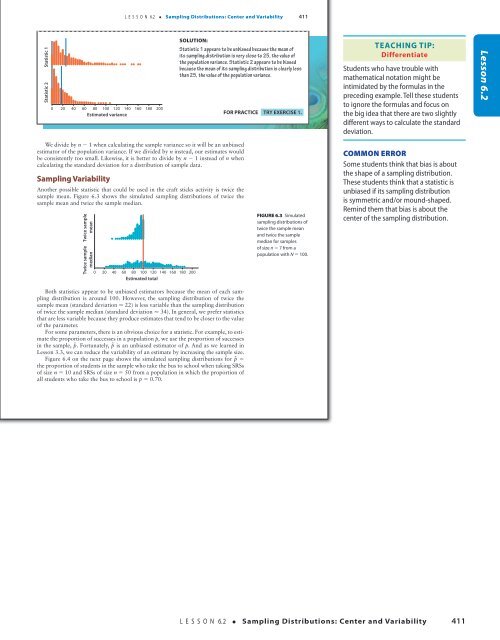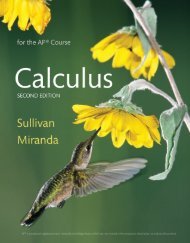SPA 3e_ Teachers Edition _ Ch 6
Create successful ePaper yourself
Turn your PDF publications into a flip-book with our unique Google optimized e-Paper software.
L E S S O N 6.2 • Sampling Distributions: Center and Variability 411<br />
Statistic 1<br />
Statistic 2<br />
0 20 40 60 80 100 120 140 160 180 200<br />
Estimated variance<br />
SOLUTION:<br />
Statistic 1 appears to be unbiased because the mean of<br />
its sampling distribution is very close to 25, the value of<br />
the population variance. Statistic 2 appears to be biased<br />
because the mean of its sampling distribution is clearly less<br />
than 25, the value of the population variance.<br />
FOR PRACTICE TRY EXERCISE 1.<br />
Teaching Tip:<br />
Differentiate<br />
Students who have trouble with<br />
mathematical notation might be<br />
intimidated by the formulas in the<br />
preceding example. Tell these students<br />
to ignore the formulas and focus on<br />
the big idea that there are two slightly<br />
different ways to calculate the standard<br />
deviation.<br />
Lesson 6.2<br />
We divide by n 2 1 when calculating the sample variance so it will be an unbiased<br />
estimator of the population variance. If we divided by n instead, our estimates would<br />
be consistently too small. Likewise, it is better to divide by n 2 1 instead of n when<br />
calculating the standard deviation for a distribution of sample data.<br />
Sampling Variability<br />
Another possible statistic that could be used in the craft sticks activity is twice the<br />
sample mean. Figure 6.3 shows the simulated sampling distributions of twice the<br />
sample mean and twice the sample median.<br />
Twice sample<br />
mean<br />
Twice sample<br />
median<br />
d<br />
dd<br />
d ddd dddd<br />
d<br />
d<br />
d<br />
d<br />
d<br />
d d dd d d d d dd<br />
dd ddddddddd<br />
dd d d dddddd<br />
ddd d d d dddd<br />
0 20 40 60 80 100 120 140 160 180 200<br />
Estimated total<br />
Both statistics appear to be unbiased estimators because the mean of each sampling<br />
distribution is around 100. However, the sampling distribution of twice the<br />
sample mean (standard deviation ≈ 22) is less variable than the sampling distribution<br />
of twice the sample median (standard deviation ≈ 34). In general, we prefer statistics<br />
that are less variable because they produce estimates that tend to be closer to the value<br />
of the parameter.<br />
For some parameters, there is an obvious choice for a statistic. For example, to estimate<br />
the proportion of successes in a population p, we use the proportion of successes<br />
in the sample, p^ . Fortunately, p^ is an unbiased estimator of p. And as we learned in<br />
Lesson 3.3, we can reduce the variability of an estimate by increasing the sample size.<br />
Figure 6.4 on the next page shows the simulated sampling distributions for p^ 5<br />
the proportion of students in the sample who take the bus to school when taking SRSs<br />
of size n 5 10 and SRSs of size n 5 50 from a population in which the proportion of<br />
all students who take the bus to school is p 5 0.70.<br />
FigUre 6.3 Simulated<br />
sampling distributions of<br />
twice the sample mean<br />
and twice the sample<br />
median for samples<br />
of size n 5 7 from a<br />
population with N 5 100.<br />
Common Error<br />
Some students think that bias is about<br />
the shape of a sampling distribution.<br />
These students think that a statistic is<br />
unbiased if its sampling distribution<br />
is symmetric and/or mound-shaped.<br />
Remind them that bias is about the<br />
center of the sampling distribution.<br />
18/08/16 4:59 PMStarnes_<strong>3e</strong>_CH06_398-449_Final.indd 411<br />
18/08/16 5:00 PM<br />
L E S S O N 6.2 • Sampling Distributions: Center and Variability 411<br />
Starnes_<strong>3e</strong>_ATE_CH06_398-449_v3.indd 411<br />
11/01/17 3:54 PM




